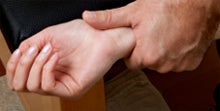Trigger Finger
 What causes trigger finger, and what are the symptoms?
What causes trigger finger, and what are the symptoms?
Somewhat similar to carpal tunnel syndrome, trigger finger also involves a narrowing around a tendon that causes pain. Also known as stenosing tenosynovitis, trigger finger occurs when a finger or thumb sticks in a bent position and straightens quickly, much like pulling and releasing a trigger. In severe cases, the fingers lock in the bent position.
More common in women and people with diabetes, trigger finger occurs when the lubricating fluid in the finger — tenosynovium — becomes inflamed and narrows the space around the tendon. The un-lubricated tendon, then, catches in a bent position before popping straight, and each time this happens, the tendon itself becomes more irritated.
What are the symptoms, and how is it treated?
Trigger finger symptoms include: finger stiffness, usually in the morning; popping or clicking as the finger moves; a bump or tenderness at the base of the affected finger; finger catching and popping straight; finger locking and sticking in a bent position. You’re more likely to experience trigger finger in the thumb or ring finger of your dominant hand. It is possible for both hands and multiple fingers to be involved.
Our orthopaedists will conduct a physical exam, asking you to open and close your hand, and will review your symptoms. For mild cases, splinting, finger exercises, and avoiding repeated gripping can be recommended. More serious cases could require nonsteroidal anti-inflammatory drugs, steroid injections, a procedure that uses a needle to release the locked tendon, or surgery.
Many trigger finger release surgeons are now completed using minimally invasive techniques.